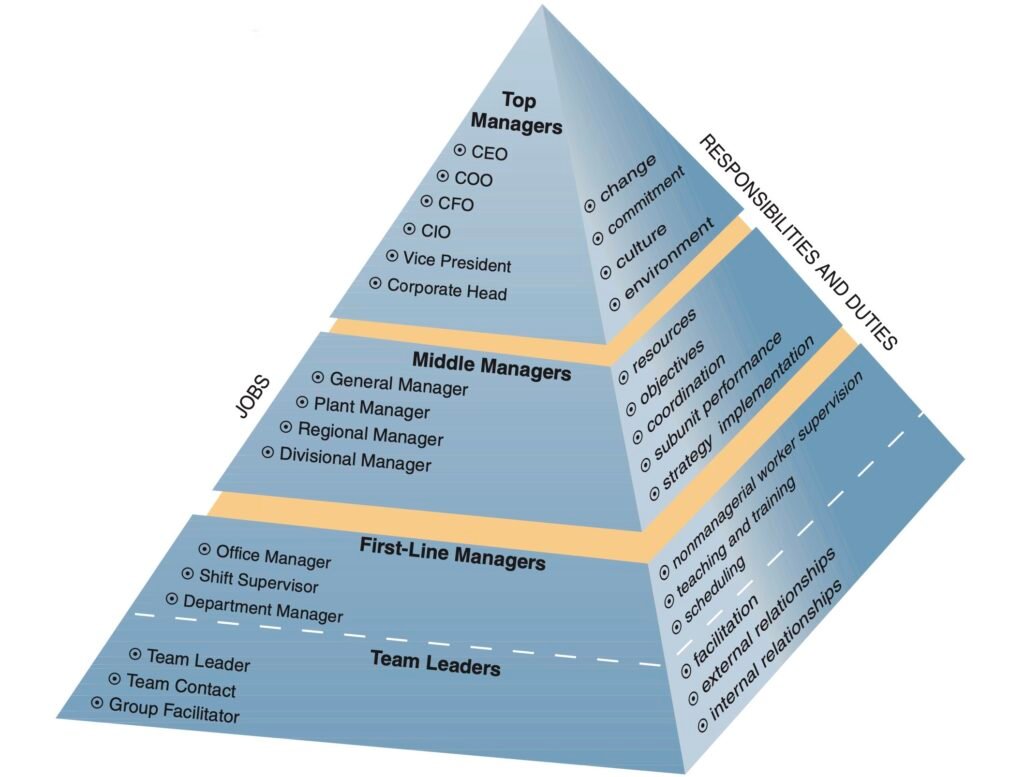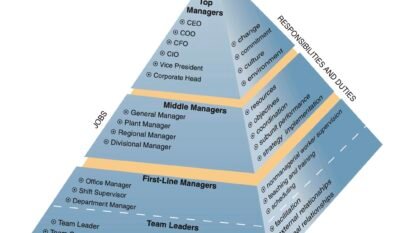Not all managerial jobs are the same. The needs and prerequisites placed on the CEO of Toyota are significantly different from those set on your local Tim Hortons restaurant manager. After reading this post, you should be able to define various sorts of managers. Just as not all managerial jobs are the same, not all managers are the same.
As shown in the image below, there are four kinds of managers, each with different jobs and responsibilities:
- Top managers,
- Middle managers,
- First-line managers, and
- Team leaders.

Top Managers
Top managers hold positions like chief executive officer (CEO), chief operating officer (COO), chief financial officer (CFO), and chief information officer (CIO). They are responsible for the overall direction of the organization. Top managers have the following responsibilities: First, they are accountable for creating a context for change. Andrew Mason, the CEO of Groupon, was fired because he could not reverse a 77 percent decline in the company’s stock price.
Thirty-five percent of all CEOs are eventually fired because of their inability to change their companies successfully. Creating a context for change includes forming a long-range vision or mission for the company. As one CEO said, “The CEO has to think about the future more than anyone.”
The second responsibility of top managers is to develop employees’ commitment to and ownership of the company’s performance. That is, top managers are responsible for creating employee buy-in.
Third, top managers must create a positive organizational culture through language and action. Top managers impart company values, strategies, and lessons through what they do and say to others inside and outside the company. Kimberly Till, CEO of Harris Interactive, a New York market research company, emphasizes the importance of frequent communication, saying, “I keep all the employees in the loop through weekly e-mails, town hall meetings and forums, video clips of big decisions, and visits to the offices.”
Finally, top managers are responsible for monitoring their business environments. This means that top managers must closely monitor customer needs, competitors’ moves, and long-term business, economic, and social trends.
Middle Managers
Middle managers hold positions like plant manager, regional manager, or divisional manager. They are responsible for setting objectives consistent with top management’s goals and planning and implementing subunit strategies to achieve those objectives. One specific middle-management responsibility is to plan and allocate resources to meet objectives.
A second primary responsibility is coordinating and linking a company’s groups, departments, and divisions. The merger between United and Continental Airlines was executed by 33 integration teams headed by middle managers like Sherri Kawell. Kawell’s team found that the two airlines had very different minors travelling alone policies. United identified the minors by pinning a button on their shirts, whereas Continental used plastic wristbands. Kawell’s team coordinated this part of the merger by deciding on wristbands because they are more challenging for children to remove. Said Kawell, “There’s no right answer. We’re not taking everything from one airline.”
The third responsibility of middle management is to monitor and manage the performance of the subunits and individual managers who report to them. After Johnson & Johnson’s (J&J) McNeil Consumer Healthcare division experienced repeated manufacturing problems that led to a recall of children’s Tylenol, Motrin, and Benadryl, J&J’s Ajit Shetty, who runs the company’s oversight group, was given the responsibility for maintaining quality standards in the company’s consumer, medical device, and pharmaceutical segments. By having all middle managers from each business group and manufacturing facility report to Shetty, J&J sought to maintain its high standards uniformly.
Finally, middle managers are also responsible for implementing the changes or strategies generated by top managers.
First-Line Managers
First-line managers hold office manager, shift supervisor, or department manager positions. The primary responsibility of first-line managers is to manage the performance of entry-level employees who are directly responsible for producing a company’s goods and services. Thus, first-line managers are the only managers who don’t supervise other managers. The responsibilities of first-line managers include monitoring, teaching, and short-term planning.
First-line managers encourage, monitor, and reward the performance of their workers. When Intuit bought Pay cycle, Jennifer Lepard stayed up all night to determine how Paycycle’s employees’ salary structure should be integrated with Intuit’s. When her acquisition team manager, a first-line manager, thanked her, Jennifer was thrilled; “The fact that somebody took the time to recognize the effort made the long hours just melt away.”
First-line managers also teach entry-level employees how to do their jobs. Damian Mogavero’s company, Avero LLC, helps restaurants analyze sales data for each restaurant’s wait staff member. According to Mogavero, restaurant managers who use these data will often take their top-selling servers to lunch weekly as a reward. However, the best managers will also take their poorest-selling servers out to lunch to discuss what they can do to improve their performance.
First-line managers also make detailed schedules and operating plans based on middle management’s intermediate-range plans. In contrast to the long-term objectives of top managers (3 to 5 years out) and the intermediate goals of middle managers (6 to 18 months out), first-line managers engage in plans and actions that typically produce results within two weeks.
Team leaders
The fourth kind of manager is a team leader. This relatively new management job developed as companies shifted to self-managing teams, which, by definition, have no formal supervisor. In traditional management hierarchies, first-line managers are responsible for the performance of nonmanagerial employees and have the authority to hire and fire workers, make job assignments, and control resources. In this new structure, the teams themselves perform nearly all of the functions performed by first-line managers under traditional hierarchies. Team leaders have a different set of responsibilities than traditional first-line managers. Team leaders are primarily responsible for facilitating team activities toward accomplishing a goal. This doesn’t mean team leaders are responsible for team performance. They aren’t; the team is. Team leaders help their team members plan and schedule work, learn to solve problems and work effectively with each other, but the team members on the outcome. The leader is there to bring intellectual, emotional, and spiritual resources to the team. Through their actions, the leader should be able to show others how to think about the work they’re doing in their lives.
Team leaders are responsible for fostering good relationships and addressing their teams’ problems. Relationships among team members are crucial to good team performance and must be well managed. GitHub, a San Francisco–based software company, uses team structures and team leaders to decide the projects on which its 170 employees will work. After only a few months at the company, Tim Clem, who had not previously led a team, convinced his GitHub colleagues to work on a new product he had designed for Microsoft Windows. Without their approval, he would not have gotten the go-ahead and the resources to hire people to do the project.
Team leaders are also responsible for managing external relationships. Team leaders act as the bridge or liaison between their teams and other teams, departments, and divisions in a company. For example, if a member of Team A complains about the quality of Team B’s work, Team A’s leader is responsible for solving the problem by initiating a meeting with Team B’s leader. Together, these team leaders are responsible for getting members of both teams to work together to solve the problem. If it’s done right, the problem is solved without involving company management or blaming the other team members.
Review. Kinds of Managers
There are four different kinds of managers:
- Top managers are responsible for creating a context for change, developing attitudes of commitment and ownership, creating a positive organizational culture through words and actions, and monitoring their company’s business environments.
- Middle managers are responsible for planning and allocating resources, coordinating and linking groups and departments, monitoring and managing the performance of sub-units and managers, and implementing the changes or strategies generated by top managers.
- First-line managers are responsible for managing the performance of nonmanagerial employees, teaching entry-level employees how to do their jobs, and making detailed schedules and operating plans based on middle management’s intermediate-range plans.
- Team leaders are responsible for facilitating team performance, managing external relationships, and facilitating internal team relationships.
















Interested